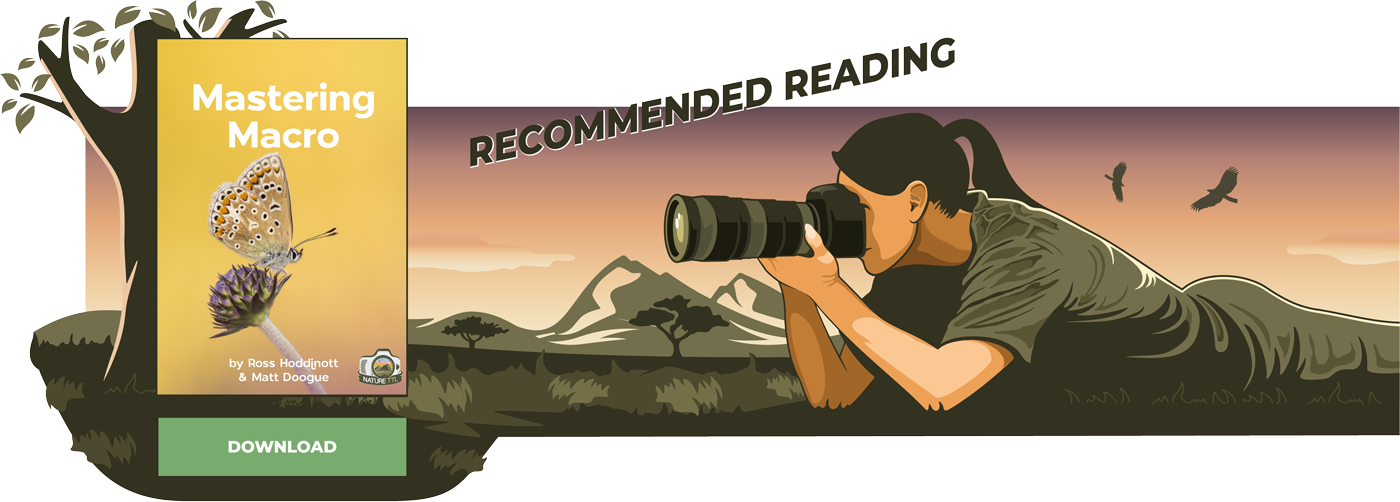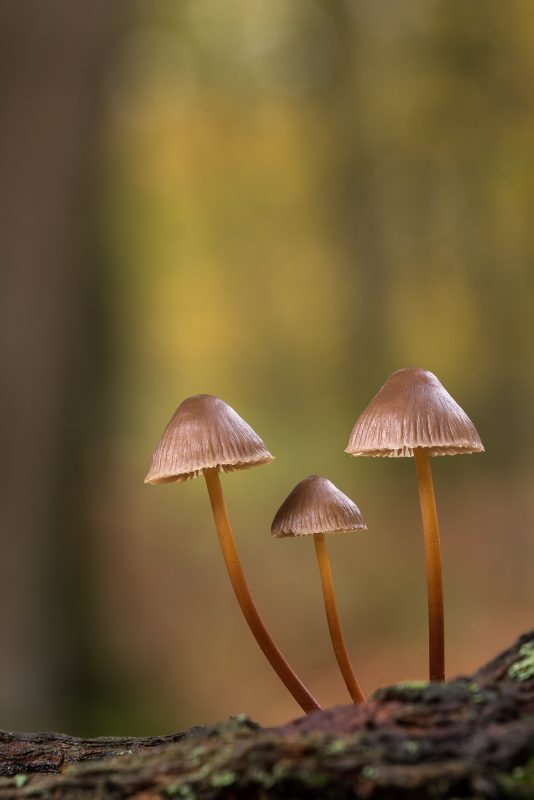5 Autumn Photography Ideas for Macro Photographers

Spring and summer are busy times of year for close-up and macro photographers. The countryside is buzzing with activity and there is an abundance of butterflies, dragonflies, and other interesting and colourful miniature subjects to photograph. But come the end of summer, the temperature drops, leaves begin to fall, and insect numbers quickly retreat. So what do close-up enthusiasts like you and me do? Do we simply twiddle our thumbs and allow our macro kit to get dusty until the following spring? If you do, you will be missing out on a rich variety of photo opportunities.
At this very atmospheric time of year, a woodland is colourful and home to all types of weird and wonderful fungi and seasonal fruits. On cool, dewy mornings, grasses and spiders’ webs are decorated with tiny droplets of water while the ground frosts create yet more interesting close-up opportunities.


Still need convincing? Why don’t we take a closer look at some of my autumn photography ideas.
#1 Autumn leaves
For just a few short, golden weeks of the year, deciduous foliage is enhanced by one of nature’s most impressive events. For much of the year, the pigments that give leaves their fiery seasonal colours are masked by chlorophyll. However, as this green pigment begins to break down in the autumn, the other pigments (carotenoids and anthocyanins) are revealed.
Dry, sunny weather combined with cool nights trigger this intense, photogenic palette of reds, yellows and oranges. The peak of autumn colour in the UK can change slightly from year to year, but is typically at its best towards the end of October and early November. While many outdoor photographers prefer to capture fall colour in wide-angle landscapes, colourful leaves are hugely photogenic in close-up. When photographing leaves still attached to trees, try to shoot them backlit by sandwiching your subject between you and sun. Backlighting is often best for translucent subjects like leaves, highlighting colour, shape, form and intricate detail. However, you need the conditions to be still, otherwise wind motion will make it tricky to compose and focus.
Read more: How to Photograph Backlit Autumn Leaves with Flash

Fallen leaves are most photogenic with a touch of frost, or adorned with tiny dew or raindrops, which add scale and interest. If you can’t ‘see’ an obvious shot, why not collect a handful of colourful, shapely leaves (maple leaves are always a good choice) to take home and photograph. You can then arrange them more creatively in the comfort and warmth of your own home using diffused window light. Alternatively, place them on an old lightbox (if you have one) to replicate the effect of natural backlighting. Try attaching a polariser when shooting foliage – the filter will reduce glare reflecting off wet or shiny leaves, restoring natural colour saturation as a result.
#2 Dewy cobwebs
Surely no self-respecting close-up photographer can resist photographing a dewy spider’s web? Due to the cooler, moister atmosphere of autumn, it is not uncommon to wake up to heavy dew – so keep a close eye on the weather forecast. Grasses, leaves and branches will be dripping with tiny beads of water that sparkle like jewels in early morning sunlight.
But the most photogenic subjects on a dewy morning are spider webs. Dew will reveal the whereabouts of millions of webs, decorating buildings, tall grasses, reeds, and fences. They are beautiful and more than justify a closer look. The long end of a tele-zoom should allow you to capture frame-filling shots, but a dedicated macro is the better choice. If you want to record the web sharp throughout, select a parallel angle in order to place as much of the subject as possible within the plane of focus, and also select a relatively small aperture.
For more arty, interesting results, place your camera at an angle to the web and select a large aperture – in the region of f/2.8 or f/4 – to highlight just a few strands. Your choice of background is important. A messy, distracting backdrop will ruin shots, so only photograph webs where you can place some distance between it and its backdrop. For extra impact, look for webs that you can photograph against a colourful background – for example, water, sky, or a carpet of flowering heather. Depth of field is always limited when shooting at higher magnifications, so you will need to focus precisely.
Read more: How to Focus Stack Macro Photos in the Field
Use a tripod, but be careful not to knock the web (or any of the grasses supporting it) when setting up. While webs alone create great shots, don’t overlook their creator – autumn is a great time of year to photograph spiders. Lookout for little beauties like garden, orb weaver, and wasp spiders. The best conditions will be just after sunrise, before the dew begins to evaporate in the morning sunshine, so set your alarm nice and early!
#3 Fungi
Probably the most obvious autumn subjects for macro photographers are mushrooms and toadstools – they go hand-in-hand with the season. Why is autumn best for fungi? When summer’s warmth collides with the cool, dampness of autumn it creates perfect conditions for fungi to thrive. The biggest explosion is in woodland, when weird and wonderful fungi of various shape, size and guise appear among leaf clutter and decorate tree stumps and fallen branches.
Therefore, visit local woodlands regularly at this time of year with your macro gear in tow. Fungi have a habit of growing in low, awkward positions, so carry some sort of protective groundsheet with you to help keep you and kit clean and dry. Low viewpoints will often create the most natural and dramatic results, so a DSLR or mirrorless camera with an articulated screen will prove most useful, allowing you to compose images easily from awkward angles.
Watch Ross in Action: How to Photograph Woodlands (Video)
Woodland tends to be dark, so be prepared to supplement the light using either a small reflector or LED device. I often favour a worm’s eye perspective when photographing mushrooms, as this tends to exaggerate the perceived size of subjects and make them look more imposing. It also allows you to highlight the texture and repetition of their gills – one of their most interesting features. A macro lens in the region of 100mm is ideal for fungi, although a shorter focal length is useful for capturing more environmental images of subjects in context with their surroundings.
#4 Autumn fruits
Don’t overlook the fruits of autumn. At this time of year, there is no shortage of photogenic nuts and berries: conkers, acorns, fir cones, and natural fruits abound. Search the woodland floor for suitable subjects and look for ‘found still-lifes’. What is this exactly? Well, a found still-life isn’t assembled or created in a studio, but photographed in situ and shot with a fairly minimal amount of tampering.
Look for pleasing arrangements of colour, shape and texture. Don’t be afraid to tidy things up slightly if necessary – for example, remove distracting twigs or debris – and if you have to move things around slightly to improve the balance or composition, feel free to do so. Soft, diffused sunlight is typically best for this type of close-up – in high contrast light, use a reflector to relieve ugly shadow areas.
#5 Frost
As it grows colder during autumn, keep an eye on the local forecast for temperatures to dip below zero. A heavy ground frost can transform the landscape, producing fresh photo opportunities for eagle-eyed close-up photographers. A touch of frost has the ability to restore decaying leaves and vegetation to beauty. Branches, buds, grass-heads, teasels, and cobwebs will be decorated by tiny ice particles – beautiful miniature detail that can only be fully appreciated and revealed in close-up.
Again, an early start is essential before things begin to thaw and while the light is soft and warm. Gardens, moorland, and open countryside are good places to visit and search for subjects. Along rivers, look for icicles and grasses encapsulated in frozen water created by spray. Don’t forget to look down. Frozen puddles and pools can be hugely photogenic.
Cracks and bubbles trapped in ice can create abstract patterns and compelling detail. Isolate interesting areas of frozen water using a macro lens or the long end of a tele-zoom. An overhead viewpoint normally works well, while a cooler colour temperature (in the region of 3000-4000k) will add an attractive, cold blue hue to your shots.
Read more: How to Photograph Frost & Ice
So if you are a keen close-up photographer, don’t think you have to neglect your macro lens this autumn. There is no shortage of autumnal highlights to see and photograph. Have fun and good luck.












